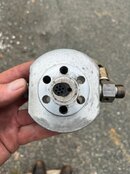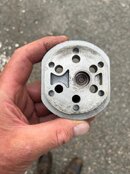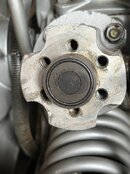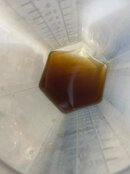You are using an out of date browser. It may not display this or other websites correctly.
You should upgrade or use an alternative browser.
You should upgrade or use an alternative browser.
1987 Bauer Capitano - Questions
- Thread starter Bloody Knuckles
- Start date
Please register or login
Welcome to ScubaBoard, the world's largest scuba diving community. Registration is not required to read the forums, but we encourage you to join. Joining has its benefits and enables you to participate in the discussions.
Benefits of registering include
- Ability to post and comment on topics and discussions.
- A Free photo gallery to share your dive photos with the world.
- You can make this box go away
Bloody Knuckles
Registered
Received and thank you 
For those who may be following along. Porter Stiles (@oldairdude) is the former owner and CEO of August Industries. (search, "New to Scubbaboard - Delayed Arrival"). Porter has been extremely helpful in providing information and direction on getting my newly acquired Bauer Capitano operational again. If you should find yourself in a similar position and more importantly, if you should be in the need of parts, Porter will most likely be able to provide or point you in the right direction. Thanks again @oldairdude, most appreciated! And good luck to all those on a similar journey.
For those who may be following along. Porter Stiles (@oldairdude) is the former owner and CEO of August Industries. (search, "New to Scubbaboard - Delayed Arrival"). Porter has been extremely helpful in providing information and direction on getting my newly acquired Bauer Capitano operational again. If you should find yourself in a similar position and more importantly, if you should be in the need of parts, Porter will most likely be able to provide or point you in the right direction. Thanks again @oldairdude, most appreciated! And good luck to all those on a similar journey.
Bloody Knuckles
Registered
Another question...
Regarding synthetic versus petroleum based lubricant. I have read that switching from petroleum based to synthetic is "not" a good idea for a compressor that has been run for greater than a hundred hours or so on petroleum based lubricant.
I have no history on the unit and I have no idea what is in the crankcase now (see attached pic). Should I just assume it's petroleum based and stick with that? It will be getting all new valves and a new floating piston. In addition the heads will be cleaned accordingly.
Thoughts???
Regarding synthetic versus petroleum based lubricant. I have read that switching from petroleum based to synthetic is "not" a good idea for a compressor that has been run for greater than a hundred hours or so on petroleum based lubricant.
I have no history on the unit and I have no idea what is in the crankcase now (see attached pic). Should I just assume it's petroleum based and stick with that? It will be getting all new valves and a new floating piston. In addition the heads will be cleaned accordingly.
Thoughts???
Attachments
oldairdude
Registered
Given the fact that you are replacing all valves and also cleaning the heads, this would be a perfect time to switch to synthetic. I might suggest you also clean out the 2nd stage separator element and take a peek in there as well. Blow out the intercoolers to insure they are clear and free. Lastly I suggest you change the oil twice. Run it for about 3 to 10 hours, then drain hot, then refill and drain on schedule.Another question...
Regarding synthetic versus petroleum based lubricant. I have read that switching from petroleum based to synthetic is "not" a good idea for a compressor that has been run for greater than a hundred hours or so on petroleum based lubricant.
I have no history on the unit and I have no idea what is in the crankcase now (see attached pic). Should I just assume it's petroleum based and stick with that? It will be getting all new valves and a new floating piston. In addition the heads will be cleaned accordingly.
Thoughts???
You are in a great opportunity to do this.
Bloody Knuckles
Registered
Excellent, execatly what I was hoping to hear, thanks again for the help / directionGiven the fact that you are replacing all valves and also cleaning the heads, this would be a perfect time to switch to synthetic. I might suggest you also clean out the 2nd stage separator element and take a peek in there as well. Blow out the intercoolers to insure they are clear and free. Lastly I suggest you change the oil twice. Run it for about 3 to 10 hours, then drain hot, then refill and drain on schedule.
You are in a great opportunity to do this.
Agro
Contributor
No need at all to change filter system. If you do so I'd like to buy your old filter. Please send me a PM for price, thank you.
Bloody Knuckles
Registered
Thanks for the offer Argo, and I understand your position or stance on the subject. Yes, I agree it's highly unlikely the P-0 purification housing would fail but having zero history subject to prior utilization in addition to some questionable "maintenance" performed on the safety valve I think it's prudent to go forward with replacement. Regarding the old one, I'd prefer to hang onto it... As stated previously, if you're in need of any parts, reach out to @oldairdude (Porter Stiles). He might still have one on hand.No need at all to change filter system. If you do so I'd like to buy your old filter. Please send me a PM for price, thank you.
Bloody Knuckles
Registered
Update:
As discussed in previous posts, all "3-stages" both intake and exhaust valves were replaced with new. In addition I installed a new floating piston and a new P-0 filtration unit. The unit is pumping out a very consistent 3.6 CFM at about 950 RPM. To date, I've filled about 50, 100 CF cylinders without issue. The only observation that gives me concern is after shutdown the P-O unit will bleed down very slowly over a period of several hours. I've checked all the fittings for leaks with soapy water and all seems fine. After shutdown, if I block the intake port with my finger for about 30 seconds or so when I remove my finger I can hear a little puff of air pressure being released... Subject to Porter's comments in post #3 it would appear that my 3rd stage discharge valve maybe faulty? As a result, I disassembled the third stage head, inspected the valve and O-ring. All looked perfect. I reassembled, gave it a test run with no change. The O-Ring appeared to be a 2-016 Duro-90. (I'll order a few and try a swap, but again the new one that was just installed with the valve looked to be in perfect condition). Regarding installation of the discharge valve / head. The valve was inserted squared up and seated properly (triple checked). The head bolts were torqued down initially to 15 ft-lbs, the allen head valve bolt installed and torqued down as much as I dared too (The Lawrence-Factor installation video calls for a good bend in the allen wrench...gotta love it ). I then re-torqued the head bolts to 18 ft-lbs and installed the acorn nut with copper gasket. Idk, but I think I got right...In regard to the filtration system, it's my understanding that in order to preserve the molecular sieve it should be maintained under pressure. In reviewing some "generic" compressor schematics subject to theory of operation, most show a non return valve (NRV) on the inlet side of the purification filter. I'm under the assumption that the discharge vale (if working properly) would function in this regard...Yes / no? Is the best course of action to install a dedicated NRV? Is there a way to test the discharge valve with it removed and in hand? Thanks in advance for any insights...R/Mike
). I then re-torqued the head bolts to 18 ft-lbs and installed the acorn nut with copper gasket. Idk, but I think I got right...In regard to the filtration system, it's my understanding that in order to preserve the molecular sieve it should be maintained under pressure. In reviewing some "generic" compressor schematics subject to theory of operation, most show a non return valve (NRV) on the inlet side of the purification filter. I'm under the assumption that the discharge vale (if working properly) would function in this regard...Yes / no? Is the best course of action to install a dedicated NRV? Is there a way to test the discharge valve with it removed and in hand? Thanks in advance for any insights...R/Mike
As discussed in previous posts, all "3-stages" both intake and exhaust valves were replaced with new. In addition I installed a new floating piston and a new P-0 filtration unit. The unit is pumping out a very consistent 3.6 CFM at about 950 RPM. To date, I've filled about 50, 100 CF cylinders without issue. The only observation that gives me concern is after shutdown the P-O unit will bleed down very slowly over a period of several hours. I've checked all the fittings for leaks with soapy water and all seems fine. After shutdown, if I block the intake port with my finger for about 30 seconds or so when I remove my finger I can hear a little puff of air pressure being released... Subject to Porter's comments in post #3 it would appear that my 3rd stage discharge valve maybe faulty? As a result, I disassembled the third stage head, inspected the valve and O-ring. All looked perfect. I reassembled, gave it a test run with no change. The O-Ring appeared to be a 2-016 Duro-90. (I'll order a few and try a swap, but again the new one that was just installed with the valve looked to be in perfect condition). Regarding installation of the discharge valve / head. The valve was inserted squared up and seated properly (triple checked). The head bolts were torqued down initially to 15 ft-lbs, the allen head valve bolt installed and torqued down as much as I dared too (The Lawrence-Factor installation video calls for a good bend in the allen wrench...gotta love it
Mine has a NRV on both sides of the filter housing plus a PMV on the discharge side which functions as an NRV. My housing will maintain pressure for as long as I've had occasion to leave it sitting.
CG43
Contributor
The discharge valve is not an NRV. It can be slightly leaky because it has to close every rotation of the compressor only for a very short time, so about 15 times per second. In order for it not to wear out too quickly, the contact pressure metal to metal must not be too high. These are therefore different conditions than the NRV between the separator and the filter, where the airflow is already much more uniform.
But a picture shows that you have the combi filter, so no NRV is possible between the separator and the filter.
This is not the best construction for a dive shop that fills tanks every day, but Bauer considers it sufficient for a recreational diver who fills tanks approximately once a week. I share this opinion, so for me, it is fine as it is.
But a picture shows that you have the combi filter, so no NRV is possible between the separator and the filter.
This is not the best construction for a dive shop that fills tanks every day, but Bauer considers it sufficient for a recreational diver who fills tanks approximately once a week. I share this opinion, so for me, it is fine as it is.
Similar threads
- Replies
- 10
- Views
- 793
- Replies
- 1
- Views
- 356
- Replies
- 3
- Views
- 251
- Replies
- 5
- Views
- 484







